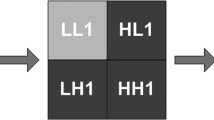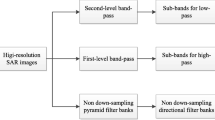Abstract
Non-Gaussian triplet Markov fields (TMF) model is suitable for dealing with multi-class segmentation of non-stationary and non-Gaussian synthetic aperture radar (SAR) images. Considering the complexity of the model and algorithm, as well as the requirement of real-time, and robust and efficient processing of SAR images, a fast algorithm based on TMF for unsupervised multi-class segmentation of SAR images is proposed in this paper. For the speckle noise in SAR images, numerical characteristic, threshold selection and QuadTree decomposition criterion are researched firstly. With the new method, a SAR image can quickly be mapped into an edge-based pixon-representation, which results in a coarse decomposition in smooth regions, and a fine decomposition in edges. Then by combining TMF model with the pixon-representation of SAR image, a new potential energy function of TMF based on pixon-representation is derived. Finally, the segmentation is finished by Bayesian maximum posterior mode (MPM). The effectiveness of the fast TMF algorithm is demonstrated by applying it to simulated data and real SAR images.
Similar content being viewed by others
References
Giordana N, Pieczynski W. Estimation of generalized multisensor hidden Markov chains and unsupervised image segmentation. IEEE Trans Pattern Anal Mach Intell, 1997, 19: 465–475
Poggi G, Scarpa G, Zerubia J. Supervised segmentation of remote sensing images based on a tree-structured MRF model. IEEE Trans Geosci Remote Sens, 2005, 43: 1901–1911
Benboudjema D, Tupin F, Pieczynski W, et al. Unsupervised segmentation of SAR images using triplet Markov fields and Fisher noise distributions. In: IEEE International Geoscience and Remote Sensing Symposium, Barcelona, Spain, 2007. 3891–3893
Benboudjema D, Pieczynski W. Multisensor triplet Markov fields and theory of evidence. Image Vision Comput, 2006, 24: 61–69
Lanchantin P, Pieczynski W. Unsupervised segmentation of triplet Markov chains hidden with long-memory noise. Adv Concepts Intell Vision Syst, 2008, 88: 1134–1151
Blanchet J, Forbes F. Triplet Markov fields for the classification of complex structure data. IEEE Trans Pattern Anal Mach Intell, 2008, 30: 1055–1067
Benboudjema D, Pieczynski W. Unsupervised image segmentation using triplet Markov fields. Comput Vision Image Understand, 2005, 99: 476–498
Benboudjema D, Pieczynski W. Unsupervised statistical segmentation of nonstationary images using triplet Markov fields. IEEE Trans Pattern Anal Mach intell, 2007, 29: 1367–1378
Benboudjema D, Pieczynski W. Segmenting non stationary images with triplet Markov fields. In: International Conference on Image Processing (ICIP2005), Geneva, Italy, 2005. 11–14
Benboudjema D, Pieczynski W. Unsupervised segmentation of non stationary images with non Gaussian correlated noise using triplet Markov fields and the Pearson system. In: Proc. IEEE Int’l Conf. Acoustics, Speech, and Signal Processing, Vol. 2, Toulouse, France, 2006
Pieczynski W. Multisensor triplet Markov chains and theory of evidence. Int J Approx Reason, 2007, 45: 1–16
Pina R K, Puetter R C. Bayesian image reconstruction: the pixon and optimal image modeling. PASP, 1993, 105: 630–637
Yang F, Jiang T. Pixon-based image segmentation with Markov random fields. IEEE Trans Image Process, 2003, 12: 1552–1559
Lin L, Zhu L, Yang F, et al. A novel pixon-representation for image segmentation based on Markov random field. Image Vision Comput, 2008, 26: 1507–1514
Papila I, Yazgan B. An unsupervised segmentation method based on MPM for SAR images. Geosci Remote Sens Lett, 2005, 2: 55–58
Jedynak B, Zheng H, Daoudi M. Skin detection using pairwise models. Image Vision Comput, 2005, 23: 1122–1130
Geman S, Geman D. Stochastic relaxation, Gibbs distributions and the Bayesian restoration of images. IEEE Trans Pattern Anal Mach Intell, 1984, 6: 721–741
Ibanez M V, Simo A. Parameter estimation in Markov random field image modeling with imperfect observations: A comparative study. Pattern Recognit Lett, 2003, 24: 2377–2389
Caves R, Quegna S, White R. Quantitative comparison of the perfomance of SAR segmentation algorithms. IEEE Trans Image Process, 1998, 7: 1534–1546
Author information
Authors and Affiliations
Corresponding author
Rights and permissions
About this article
Cite this article
Wu, Y., Wang, X., Xiao, P. et al. Fast algorithm based on triplet Markov fields for unsupervised multi-class segmentation of SAR images. Sci. China Inf. Sci. 54, 1524–1533 (2011). https://doi.org/10.1007/s11432-011-4215-x
Received:
Accepted:
Published:
Issue Date:
DOI: https://doi.org/10.1007/s11432-011-4215-x




